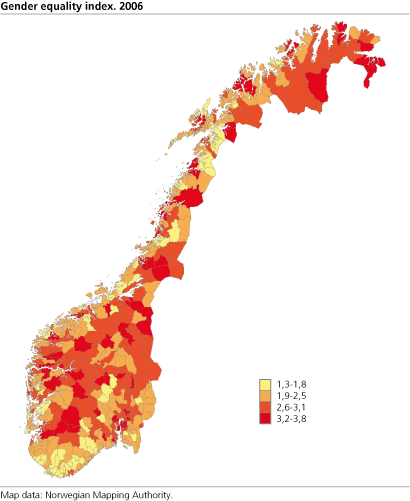Content
Published:
This is an archived release.
Most gender equality in Tromsø
The gender equality index for 2006 reveals that Tromsø is the municipality with most equality between women and men. On county level Oslo and Akershus have the highest score, while the southern counties Aust-Agder and Vest-Agder have the lowest score.
Tromsø has the highest score among the municipalities with 3.8 points. It is closely followed by last year's winner Leikanger in Sogn og Fjordane and Bodø. At the bottom of the ranking we find Vanylven, Froland and Farsund (1.3 points). The three municipalities are located in Møre og Romsdal, Aust-Agder and Vest-Agder respectively.
The six largest cities Oslo, Bergen, Stavanger, Trondheim, Drammen and Kristiansand all have scores above the national average (2.5).
|
The municipalities can achieve a maximum score of 4 and a minimum score of 1.This index is relative: The fact that a municipality has a 4 on income, for instance, does not mean that women and men have the same income, only that the municipality is placed in the highest quartile. |
Agder counties with lowest score
Women and men in the southern-most counties have the lowest score. Vest-Agder is ranked lowest with 1.9 points followed by Aust-Agder with 2.2 points.
Oslo and Akershus are the counties with the highest score with 3.1 and 3.0 points. Almost all of the municipalities of Akershus are above the national average of 2.5 points. The counties of Finnmark and Sogn og Fjordane also score high on the index (both score 2.8).
Many ways to depict gender equality
The gender equality index combines various direct and indirect measurements of gender equality that show the extent to which women and men participate in politics, education and working life.
The indicators are:
- Kindergarten coverage for children aged 1-5 (2005)
- Number of women per 100 men aged 20-39 (2005)
- Education levels for women and men (2005)
- Labour force participation for women and men (2005)
- Income for women and men (2004)
- Percentage of female municipal council members (2003)
The tables contain more detailed information on the data and index and enable users to compare counties and municipalities by individual indicators and as a total.
" About the statistics " contains information on how the index is estimated.
Tables:
- Table 1 Gender Equality Index for Norwegian municipalities, sorted by county. 2006
- Table 2 Gender Equality Index for Norwegian municipalities, by ranking. 2006
- Table 3 Gender Equality Index for Norwegian municipalities, ranked by county. 2006
- Table 4 Gender Equality Index for Norwegian municipalities, data. 2006
Additional information
The indicators of gender equality in municipalities has been published every year since 2008. The indicators are based on available statistics from registers, and measure gender equality in all municipalities and counties, as well as average for the whole country.

